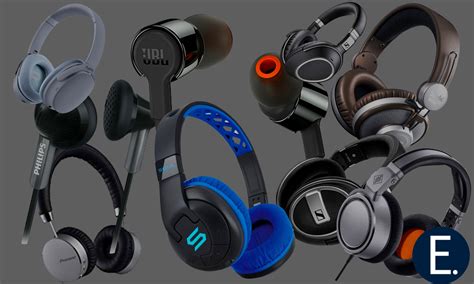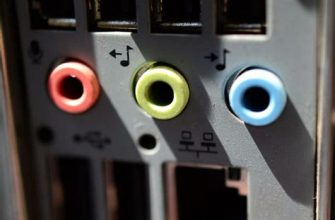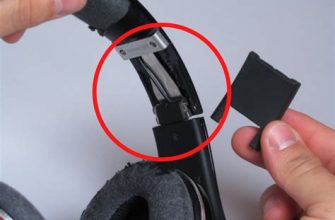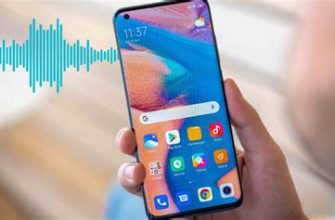When it comes to experiencing music or immersing yourself in your favorite movie, having the right sound companion can make all the difference. Whether you're a devoted audiophile or an everyday music lover, finding the ideal headphones to suit your needs and preferences is essential.
Discovering the perfect audio device involves more than just selecting any pair of earphones or headsets. It requires understanding the various factors that contribute to an immersive sound experience. From the type of headphones to consider to the features that enhance your listening pleasure, this article will guide you through the process of choosing the ultimate sound companion.
One of the key aspects to consider when searching for headphones is their form factor. There are different types of headphones available, each with its own benefits. For instance, on-ear headphones are ideal for those seeking a lightweight and portable option, while over-ear headphones offer superior comfort and excellent noise isolation. In-ear headphones, on the other hand, provide a snug fit and are perfect for travel or sports activities.
Aside from form factor, it's important to consider the audio quality delivered by the headphones. Look out for features such as frequency response, impedance, and driver size, as they greatly impact the clarity and richness of the sound. Additionally, pay attention to extra features like noise cancellation, wireless connectivity, and built-in controls, which can further enhance your listening experience and convenience.
By understanding these factors and identifying your personal preferences, you'll be able to select headphones that not only deliver outstanding sound but also suit your lifestyle. So, dive into the world of headphones and explore a range of options to find your perfect sound companion today!
Understanding Different Types of Headphones

Exploring the diverse world of audio devices, it is essential to comprehend the various categories of headphones available to help you make an informed choice. By familiarizing yourself with these different types, you can select a headphone style that aligns with your preferences and requirements.
- In-Ear Headphones: Also known as earbuds, in-ear headphones fit snugly inside the ear canal. They provide portability and are ideal for those who prioritize convenience and compactness. In-ear headphones are perfect for everyday use and are commonly used for exercising or commuting.
- On-Ear Headphones: On-ear headphones rest on the ear, covering them partially. They offer a balance between portability and sound quality. On-ear headphones are suitable for extended periods of use, as they are comfortable and generally lightweight.
- Over-Ear Headphones: Over-ear headphones envelop the entire ear, providing a comfortable fit and superior sound quality due to their larger drivers. They are renowned for exceptional noise isolation and are favored by audiophiles, professionals, and individuals seeking immersive audio experiences.
- Wireless Headphones: These headphones eliminate the need for wires, offering convenience and freedom of movement. They connect to the audio source via Bluetooth technology, enabling a wireless listening experience. Wireless headphones come in various styles, including in-ear, on-ear, and over-ear, catering to different preferences.
- Noise-Canceling Headphones: Noise-canceling headphones employ advanced technology to reduce external ambient sounds, allowing you to enjoy your audio content without distractions. These headphones are highly recommended for frequent travelers or individuals who work in noisy environments.
- Gaming Headphones: Specifically designed for gaming enthusiasts, gaming headphones feature enhanced audio capabilities and built-in microphones. They provide immersive soundscapes and clear communication during multiplayer gaming sessions.
Understanding the differences between these various types of headphones is crucial for making a well-informed decision when selecting your audio companion. Consider your lifestyle, usage scenarios, and personal preferences to identify the headphone style that best suits your needs.
Considering the Sound Quality and Frequency Response
When it comes to selecting the perfect pair of headphones, one of the most important factors to consider is the sound quality and frequency response they offer. This aspect plays a crucial role in determining the overall audio experience and ensures that you can fully immerse yourself in the music or other forms of audio entertainment.
Sound quality refers to the overall clarity, accuracy, and detail of the audio produced by headphones. It encompasses various aspects such as a balanced frequency response, minimal distortion, and accurate reproduction of different sound frequencies. A high-quality pair of headphones will deliver clear vocals, well-defined instrumentals, and a balanced audio representation across the entire frequency range.
Another crucial aspect to consider is the frequency response of the headphones. This refers to the range of frequencies that the headphones can reproduce accurately. Different headphones may have varying frequency response ranges, with some specializing in certain frequency ranges such as bass-heavy headphones or those optimized for vocal frequencies. It is important to choose headphones that align with your audio preferences.
When evaluating the sound quality and frequency response of headphones, it is beneficial to try them out personally or read reviews from trusted sources. This will give you a better understanding of how the headphones perform in real-world scenarios and can help you make an informed decision based on your desired audio experience.
In conclusion, when selecting headphones, paying attention to the sound quality and frequency response will ensure that you choose a pair that delivers immersive and accurate audio reproduction, tailored to your preferences.
Assessing the Comfort and Fit of Headphones

Ensuring a pleasant listening experience is not just about the sound quality of headphones, but also about their comfort and fit. The way headphones feel on your head can greatly impact your overall satisfaction and long-term use of the device. In this section, we will explore the various factors that contribute to the comfort and fit of headphones, allowing you to make an informed decision when selecting your ideal pair.
Physical Ergonomics:
When examining the comfort and fit of headphones, it is important to consider their physical ergonomics. This includes the design of the headband, earcups, and earpads. The headband should be adjustable to fit different head sizes comfortably, while the earcups should be well-padded and spacious enough to accommodate your ears without causing any discomfort or pressure points. Additionally, the material and cushioning of the earpads should be soft and breathable to prevent excessive heat and sweating during prolonged use.
Weight Distribution:
The weight distribution of headphones also plays a crucial role in their overall comfort. Ideally, headphones should distribute their weight evenly across your head and ears, without causing any imbalance or strain. Lightweight materials and well-designed headbands can help achieve this balance, allowing you to enjoy your music without feeling excessive pressure on certain points.
Adjustability:
The ability to adjust the fit of headphones is another important factor to consider. Adjustable headbands and swiveling earcups can help you find the perfect positioning for your head and ears. This customization not only enhances comfort but also contributes to improved sound quality, as a proper seal can be achieved, blocking out external noise and providing better bass response.
Long-term Wear:
Lastly, it is essential to assess the comfort and fit of headphones for long-term wear. Consider how the headphones feel after extended periods of use. Do they become uncomfortable or cause any pain or discomfort? It is crucial to prioritize headphones that maintain their comfort even during lengthy listening sessions, allowing you to enjoy your favorite music or audio content without any distractions.
In conclusion, assessing the comfort and fit of headphones is as important as evaluating their sound quality. By considering factors such as physical ergonomics, weight distribution, adjustability, and long-term wear, you can ensure a pleasant and enjoyable listening experience that meets your personal preferences and requirements.
Examining the Durability and Build Quality
In the realm of headphone shopping, it is crucial to consider the durability and build quality of a potential purchase. A headphone's ability to withstand daily wear and tear, as well as its overall construction, greatly impacts its longevity and performance. Understanding the key factors that contribute to durability and build quality can help users make informed decisions when selecting headphones.
- Materials Used: The choice of materials used in the construction of headphones plays a vital role in determining their durability. Headphones made from high-quality materials such as stainless steel, aluminum, or robust plastics tend to be more resistant to damage and offer increased longevity compared to those made from cheaper or flimsier materials.
- Design and Structure: The design and structure of headphones can significantly affect their durability. Headphones with a sturdy headband and well-built hinges or joints are more likely to withstand bending and twisting without breaking. Additionally, headphones with reinforced cables and strain reliefs offer increased protection against accidental tugs or pulls, minimizing the risk of cable fraying or detachment.
- Sweat and Water Resistance: For individuals who plan to use headphones during physical activities or in humid environments, considering sweat and water resistance is essential. Headphones with appropriate IPX ratings provide protection against moisture, preventing damage from perspiration, light rain, or accidental spills.
- Portability and Storage: The ease of portability and storage can also impact the overall durability of headphones. Headphones that come with a protective case or have a foldable design are better suited for frequent travelers or individuals who prefer to keep their headphones safe when not in use. Properly storing headphones reduces the risk of damage from impacts or extreme temperatures.
- Manufacturer Reputation and Warranty: Examining the reputation of manufacturers and the warranty offered with the headphones can provide insight into their build quality and durability. Reputable brands often prioritize quality control and use stringent testing procedures to ensure the longevity of their products. A substantial warranty coverage demonstrates the manufacturer's confidence in their headphones.
When selecting headphones, evaluating the durability and build quality goes beyond just focusing on sound quality and comfort. Taking the time to consider the materials, design, sweat and water resistance, portability, and the reputation of the manufacturer can help users choose headphones that will last and provide a satisfactory listening experience for years to come.
Evaluating the Wired vs. Wireless Options

When it comes to choosing headphones, one important factor to consider is whether to go with wired or wireless options. This section aims to explore the advantages and disadvantages of both options, allowing readers to make an informed decision based on their individual needs and preferences.
Wired headphones:
Wired headphones have long been a popular choice among audio enthusiasts for their reliable and high-quality sound delivery. With a physical connection to the audio source, they ensure a consistent and uninterrupted listening experience. Additionally, wired headphones do not require batteries or charging, offering the convenience of always being ready to use. However, they may limit mobility due to the presence of cables, which can get tangled or accidentally disconnected during use.
Wireless headphones:
Wireless headphones, on the other hand, provide freedom of movement and convenience without the limitations of cables. They utilize modern technologies such as Bluetooth to establish a wireless connection with the audio source, allowing users to enjoy their favorite music or audio content without the hassle of wires. Wireless headphones also offer a sleek and minimalist design, making them aesthetically appealing. However, they do require batteries or charging, which means users need to ensure they have enough power or may experience interruptions in audio playback. Additionally, some users may notice a slight decrease in sound quality compared to wired options.
Choosing the right option:
When deciding between wired and wireless headphones, it is crucial to consider your specific requirements. If sound quality and reliability are your top priorities, wired headphones may be the ideal choice. On the other hand, if freedom of movement and convenience are more important to you, wireless headphones offer the flexibility you need. Ultimately, the decision boils down to personal preference and the intended use of the headphones.
Exploring Noise-Canceling and Isolation Features
In this section, we will delve into the fascinating world of noise-canceling and isolation features available in headphones. These features play a vital role in enhancing your audio listening experience by minimizing external distractions and creating an immersive sound environment. By understanding the differences between noise-canceling and isolation technologies, you can make an informed decision when selecting the perfect pair of headphones to suit your specific needs.
Noise-Canceling Technology
Noise-canceling headphones are equipped with advanced technology that actively detects and reduces external sounds, such as background chatter, traffic noise, or airplane engine rumble. This technology utilizes built-in microphones to capture incoming audio signals and generates an equal and opposite sound wave, effectively canceling out the unwanted noise. With noise-canceling headphones, you can enjoy your favorite music or podcasts without disturbance from your surroundings and immerse yourself in pure audio bliss.
Isolation Features
In contrast to noise-canceling technology, isolation features work by physically blocking external sounds. These headphones create a seal around your ears, preventing ambient noise from entering and disturbing your listening experience. This type of isolation is commonly achieved through over-ear headphones that have padding or ear cups that completely cover your ears, effectively forming a barrier against external sounds. Additionally, some in-ear headphones utilize specially designed ear tips to provide a snug fit and eliminate background noise.
The Benefits of Noise-Canceling and Isolation
- Improved audio clarity: Noise-canceling and isolation features allow you to focus on the audio content, enhancing the clarity and detail of your music or conversations.
- Reduced fatigue: By minimizing external distractions, these features reduce listener fatigue, especially during long listening sessions.
- Travel-friendly: Noise-canceling headphones are particularly useful during flights, as they can mitigate the constant hum of the plane engines, making your journey much more comfortable.
- Enhanced concentration: Whether you are studying, working, or simply trying to concentrate in a noisy environment, noise-canceling and isolation features help create a quieter space, allowing you to focus better.
- Health benefits: By reducing the need to increase the volume to overcome external noise, these features contribute to protecting your hearing health in the long run.
Understanding the benefits and differences between noise-canceling and isolation features will enable you to make a well-informed decision and choose headphones that enhance your listening experience while aligning with your specific preferences and requirements.
Taking Into Account the Portability and Storage

When it comes to selecting the ideal headphones, it is crucial to take into consideration their portability and storage capabilities. Being able to comfortably carry and store your headphones is essential for convenient use, especially when you are on the go or need to pack them for travel.
One aspect to consider is the size and weight of the headphones. Opting for a compact and lightweight design allows for easy portability and adds to the overall convenience factor. Additionally, headphones that offer foldable or collapsible features are advantageous as they take up less space when not in use.
The storage options provided by the headphones should also be carefully assessed. Some models come with a protective carrying case, ensuring the longevity of your headphones and providing a secure and organized way to transport them. Others may have built-in storage compartments or cable management systems, which are useful for keeping the headphones tangle-free and easily accessible.
Another important factor to consider is the durability of the headphones. Since portable headphones are more prone to wear and tear, selecting a model made with high-quality materials and sturdy construction is paramount in ensuring their longevity.
- Look for headphones with a flexible headband that can withstand bending and twisting without breaking.
- Consider headphones with detachable cables to prevent potential damage to the connection points.
- Check if the ear cups are padded and cushioned for optimal comfort during extended use.
Overall, taking into account the portability and storage features of headphones is essential for a seamless and hassle-free listening experience, whether you are commuting, traveling, or simply on the move.
Exploring the Brand Reputation and Customer Feedback
In the process of selecting the perfect set of headphones, it is essential to evaluate the brand reputation and consider customer reviews. By conducting comprehensive research on the brand and examining the experiences shared by previous customers, you can gain valuable insights into the quality, reliability, and overall satisfaction associated with a particular headphone brand.
To begin, it is advisable to embark on a journey of brand exploration. This entails delving into the history and background of the headphone manufacturers, uncovering their mission, values, and commitment to delivering exceptional audio products. Understanding the essence of a brand can help you gauge their dedication to innovation, craftsmanship, and customer care.
Next, it is crucial to navigate through the vast sea of customer reviews, which serve as a treasure trove of information. These testimonials provide firsthand accounts of individuals who have already experienced the headphones you are considering. By studying these reviews, you can identify common themes, recurring praises, and potential concerns related to the brand's products.
- Look for patterns in the reviews, such as consistent comments on audio quality, comfort, or durability.
- Pay attention to any recurring issues or complaints, as these might indicate potential drawbacks or limitations.
- Consider the demographics of the reviewers, as different individuals may have varying preferences and expectations.
- Take note of any accolades or awards received by the brand, which can provide additional validation of their reputation.
While researching brand reputation and customer feedback, it is essential to approach the task with an open mind. Remember that each individual's experience can differ, and what may be a drawback to one person might not be a concern for another. By gathering a diverse range of perspectives, you can make a more informed decision and select headphones that align with your unique preferences and requirements.
Examining the Price Range and Budget

Delving into the aspect of price range and budget is crucial when searching for the perfect headphones. This section aims to provide an analysis of various price points and their implications for buyers.
When considering headphones, it's important to strike a balance between price and quality. While it's tempting to opt for the most affordable option, compromising on the price may result in subpar audio experience and longevity. On the other hand, investing in high-end headphones may exceed your budget without providing significant added benefits.
To begin the analysis, it's essential to determine your budget range. Consider your personal preferences, needs, and priorities when it comes to audio quality. Are you an avid music listener looking for an immersive sound experience, or are you simply searching for a reliable pair for casual use?
The market offers headphones across a wide spectrum of price ranges, ranging from budget-friendly to luxury options. It's crucial to be realistic about the specific features and quality you can expect within your budget. Keep in mind that higher-priced headphones often incorporate advanced technologies, such as noise cancellation or wireless connectivity, which can enhance your listening experience.
Another factor to consider is the durability and longevity of the headphones. While cheaper options may seem appealing initially, they may have a shorter lifespan due to lower-quality materials and construction. Investing in headphones that offer better build quality and durability can save you money in the long run, as you won't need to replace them as frequently.
Ultimately, it's important to strike a balance between your budget and the features you desire. Consider reading reviews and researching different headphone models within your budget range to identify the best options available. Remember, the goal is to find headphones that perform well, offer good value for money, and align with your specific needs and preferences.
Seeking Expert Advice and Testing Headphones Firsthand
One crucial aspect of finding the perfect pair of headphones is seeking professional advice and trying them out personally. Through the guidance of experts in the field, you can gain valuable insights and recommendations tailored to your specific needs and preferences.
An effective approach to obtaining professional advice is by visiting specialized audio stores or consulting with audio enthusiasts and professionals. These individuals possess an in-depth understanding of the intricacies of headphones, including sound quality, comfort, durability, and various other important factors. Their expertise can help steer you towards options that will best suit your requirements.
Additionally, trying out headphones in person allows you to experience their performance firsthand. This hands-on approach enables you to assess various features, such as sound clarity, bass response, noise cancellation, and overall comfort. By physically wearing and testing different models, you can gain a more accurate understanding of the headphones' performance and determine if they meet your expectations.
- Visit audio stores that offer headphone demonstrations
- Consult with experts and professionals in the audio industry
- Ask for personalized recommendations based on your preferences
- Test different headphones to assess sound quality and comfort
- Consider the durability and build quality of the headphones
- Pay attention to special features such as noise cancellation or wireless connectivity
By seeking professional advice and trying out headphones personally, you can make a more informed decision when selecting the perfect pair. Remember to prioritize your specific needs and preferences, ensuring that the headphones you choose provide the optimal listening experience for you.
How to choose the best headphones for you
How to choose the best headphones for you by Expert Reviews 951 views 1 year ago 3 minutes, 23 seconds
FAQ
What are the most important factors to consider when choosing headphones?
When choosing headphones, it is important to consider factors such as sound quality, comfort, durability, and connectivity options. Sound quality determines the clarity and detail of audio, comfort ensures that you can wear the headphones for extended periods without discomfort, durability affects the lifespan of the headphones, and connectivity options determine compatibility with your devices.
Are wired headphones better than wireless ones?
Both wired and wireless headphones have their own advantages and drawbacks. Wired headphones generally offer better sound quality and don't require charging, but they limit your mobility. On the other hand, wireless headphones provide convenience and freedom of movement, but may experience occasional connectivity issues and require battery charging.
What is the difference between over-ear and in-ear headphones?
Over-ear headphones, also known as circumaural headphones, completely enclose your ears and usually have larger earcups. They offer better sound isolation and generally provide a more immersive audio experience. In-ear headphones, also known as earbuds or in-ear monitors, fit inside your ear canal. They are more portable and offer better noise isolation, making them ideal for use in noisy environments or during physical activities.
Can I use gaming headphones for listening to music?
Yes, you can definitely use gaming headphones for listening to music. However, gaming headphones are specifically designed to enhance the audio experience during gaming sessions, so they may have emphasis on certain frequencies such as bass for a more immersive gaming experience. If you prioritize accurate music reproduction, you might want to consider headphones specifically designed for music listening.
What is an impedance and why does it matter when choosing headphones?
Impedance refers to the electrical resistance of the headphones measured in ohms. It affects the amount of power required to drive the headphones. Low-impedance headphones are easier to drive and can be used with a wider range of devices, including smartphones and portable audio players. High-impedance headphones require more power and are typically used with dedicated headphone amplifiers or audio equipment. The impedance of the headphones should match the output impedance of the audio source for optimal performance.
What factors should I consider when choosing headphones?
When choosing headphones, there are several factors to consider. First, consider the type of headphones you prefer - in-ear, on-ear, or over-ear headphones. Then, think about the sound quality, comfort, durability, and price range that suits your needs and budget. Additionally, consider if you require any special features such as noise cancellation or wireless connectivity.
What is the difference between in-ear, on-ear, and over-ear headphones?
The main difference between these types of headphones is how they fit on or in your ears. In-ear headphones, also known as earbuds, are small and fit directly into the ear canal. On-ear headphones have ear cups that rest on the outer ear, while over-ear headphones have larger cups that fully enclose the ears. Each type has its advantages and disadvantages, and the choice depends on personal preference and comfort.




